
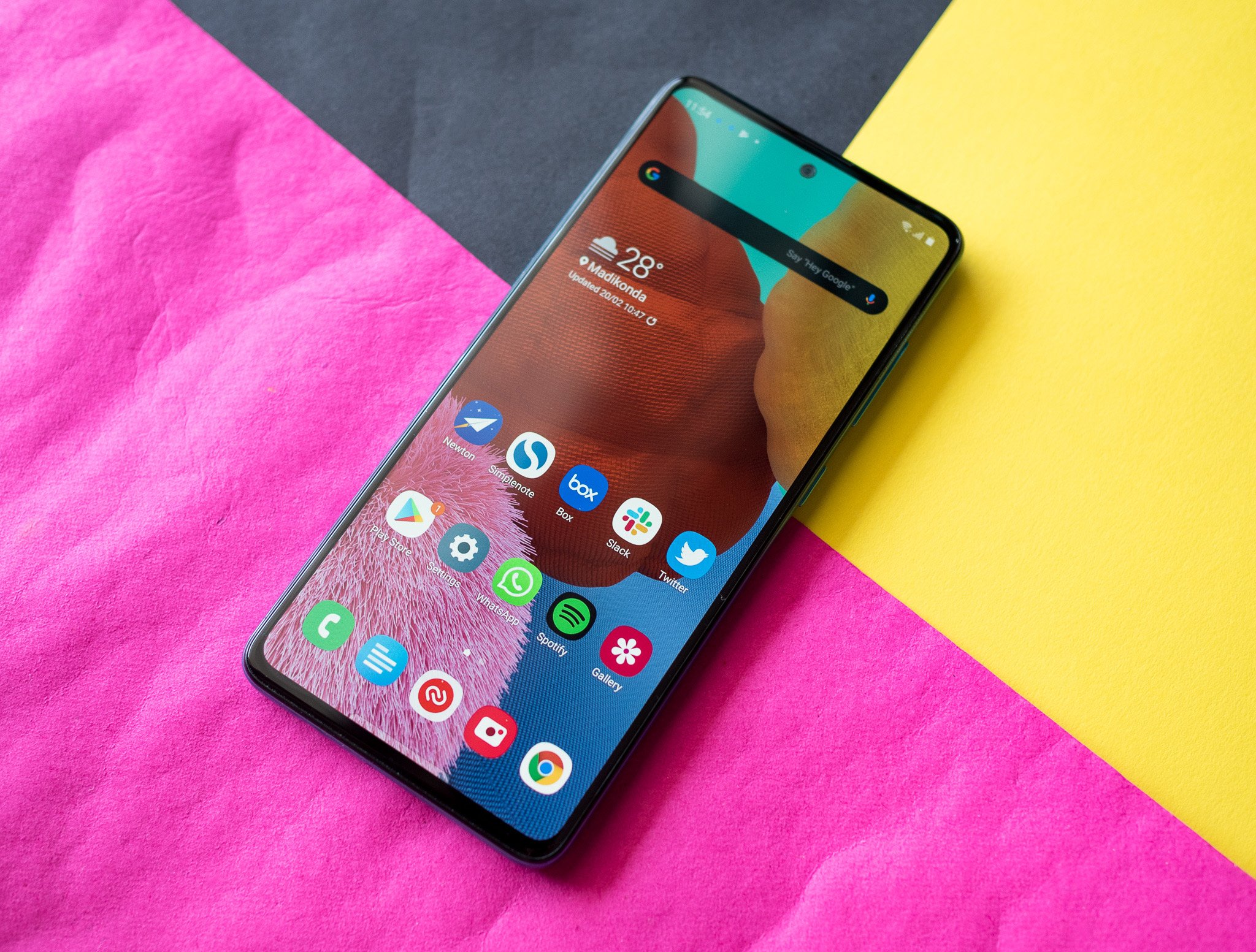 Source: Apoorva Bhardwaj / Android Central
Source: Apoorva Bhardwaj / Android Central

 Source: Apoorva Bhardwaj / Android Central
Source: Apoorva Bhardwaj / Android Central
Under increased pressure from Chinese rivals, Samsung overhauled its budget strategy last year. The underwhelming Galaxy J series was gone, and the Galaxy A lineup essentially took its place. Samsung traditionally limited the Galaxy A series to the mid-range segment, but now it fields devices starting as low as $120 all the way to $600.
The new-found change in focus also came with better product releases. The Galaxy A50 was one of the best budget phones you could buy in 2019, featuring great hardware, a fresh design, and decent cameras. In typical Samsung fashion, the company introduced an updated model six months down the line in the Galaxy A50s, and now we have the Galaxy A51.
The Galaxy A51 is a continuation of what Samsung has been doing in this segment for the last 12 months. There are a few enticing changes — particularly around the camera side of things — but the fundamentals are unchanged from last year. In fact, 80% of what I wrote in my Galaxy A50 review last year is relevant for the A51, because the underlying hardware hasn’t changed much.
That said, the Galaxy A51 isn’t a bad phone. If anything, the new design and the fact that it comes with One UI 2.0 based on Android 10 out of the box makes it a decent option for under $350. With the phone slated to go on sale in the U.S. and other global markets later this year, let’s find out if it may just be the budget phone for you in 2020.
Bottom line: The Galaxy A51 shares the same fundamentals of last year’s A50 and A50s. The 48MP camera takes decent shots during the day, you get all-day battery life, a vibrant AMOLED display, 3.5mm jack, and Android 10. But the hardware just doesn’t hold up in 2020, and there are much better alternatives available at the same price point.

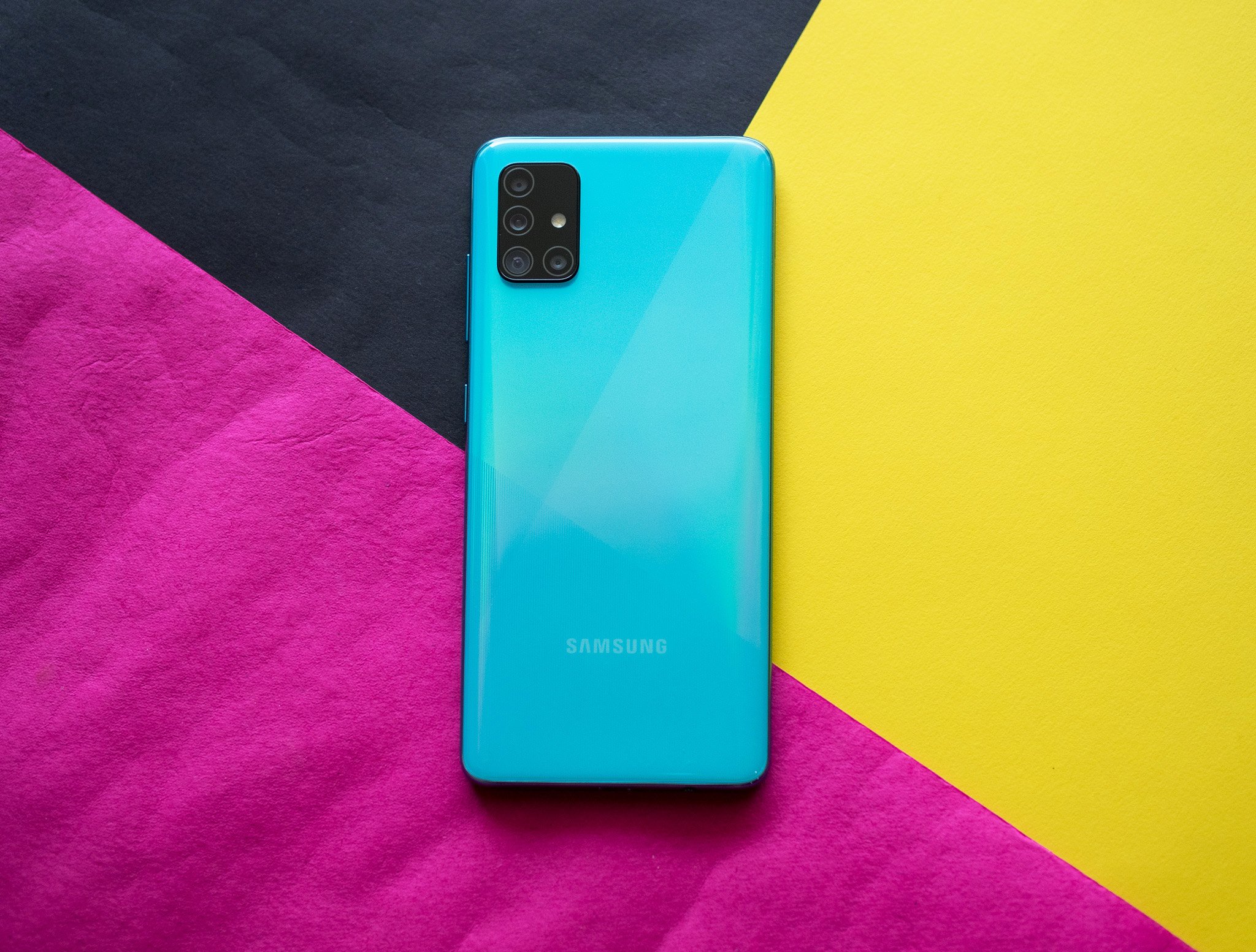 Source: Harish Jonnalagadda / Android Central
Source: Harish Jonnalagadda / Android Central
No other brand rolls out iterative updates quite like Samsung, and in the last five years it has managed to turn iteration into an art form. The Galaxy A51 takes a lot of cues from the A50s, which in turn was based on the A50. So essentially, a lot of the internal hardware that you get in the A51 is over a year old at this point.
But that doesn’t mean there are no new features on the A51. Let’s start with the back: the A51 has two diagonal lines across its surface that break up the design — just like the A50s — but this time there’s a gradient effect that shows up when light hits the surface. That gradient effect is the basis for the device’s colors, with the A51 available in Prism Crush Black, Prism Crush Blue, and Prism Crush White.
With a vibrant design and Infinity-O cutout, the Galaxy A51 is one of the best-looking phones Samsung has released.
The lower quadrants also feature subtle lines that further differentiates the design, and the overall effect is that the A51 is one of the best-looking phones Samsung has released to date. I’m using the blue option, and the vibrant color makes the phone stand out. Like last year, the back is made out of plastic, but the glossy finish gives it a glass-like feel. The best part is that it doesn’t smudge as easily as a glass back, and it is more durable.
Another major change at the back is the camera housing. The rectangular camera housing is identical to that of the Galaxy S20 series, and it’s clear that Samsung is trying to create a design identity here. While the camera housing is by no means attractive, it is consistent across all of Samsung’s 2020 devices.
The major design change at the front is the Infinity-O cutout for the front camera module. Last year’s A50 and A50s featured the Infinity-U cutout, and the cutout on the A51 is smaller and better integrated into the design. The bezels are razor-thin this time around, and it makes using the A51 that much more enticing.
Rounding out the design, you’ll find the power and volume buttons on the right, and the 3.5mm jack, USB-C charging port, and a solitary speaker at the bottom. Samsung has also moved away from the 3.5mm jack on its flagships, so it’s good to see the analog jack intact on the A51. The SIM card tray is on the left, and you get the option to slot two SIM cards as well as a MicroSD card. Of course, the variant of the A51 sold in global markets will likely have a single SIM slot.
The Galaxy A51 is astonishingly light at 172g for a phone that has a 4000mAh battery, and it has a great in-hand feel thanks to the subtle curves at the back. With a width of 73.6mm, the phone is also narrow, and while it isn’t conducive for one-handed usage, it is on the lower end of the scale as far as phone sizes go in 2020.
The Galaxy A51 has the same AMOLED display as last year’s A50, but that’s not a bad thing.
Coming to the screen, the Galaxy A51 has a 6.5-inch Super AMOLED display that ticks all the right boxes. Colors are vibrant, you get decent viewing angles, and there weren’t any issues while using the screen under harsh sunlight. You get to choose from Natural or Vivid picture modes, and there’s no option to manually tweak the color balance of the screen.
But you do a blue light filter that can be customized to run from sunset to sunrise, and you get the other scaling and font sizing options that are standard on all Samsung phones. The screen is protected by a layer of Gorilla Glass 3, another area that’s unchanged from last year. That’s true for the panel quality itself — other than the switch to an Infinity-O cutout and a minor 0.1-inch increase in screen size, there isn’t any difference from the A50 or A50s. That’s not necessarily a bad thing though, as the screen holds up just fine in 2020.

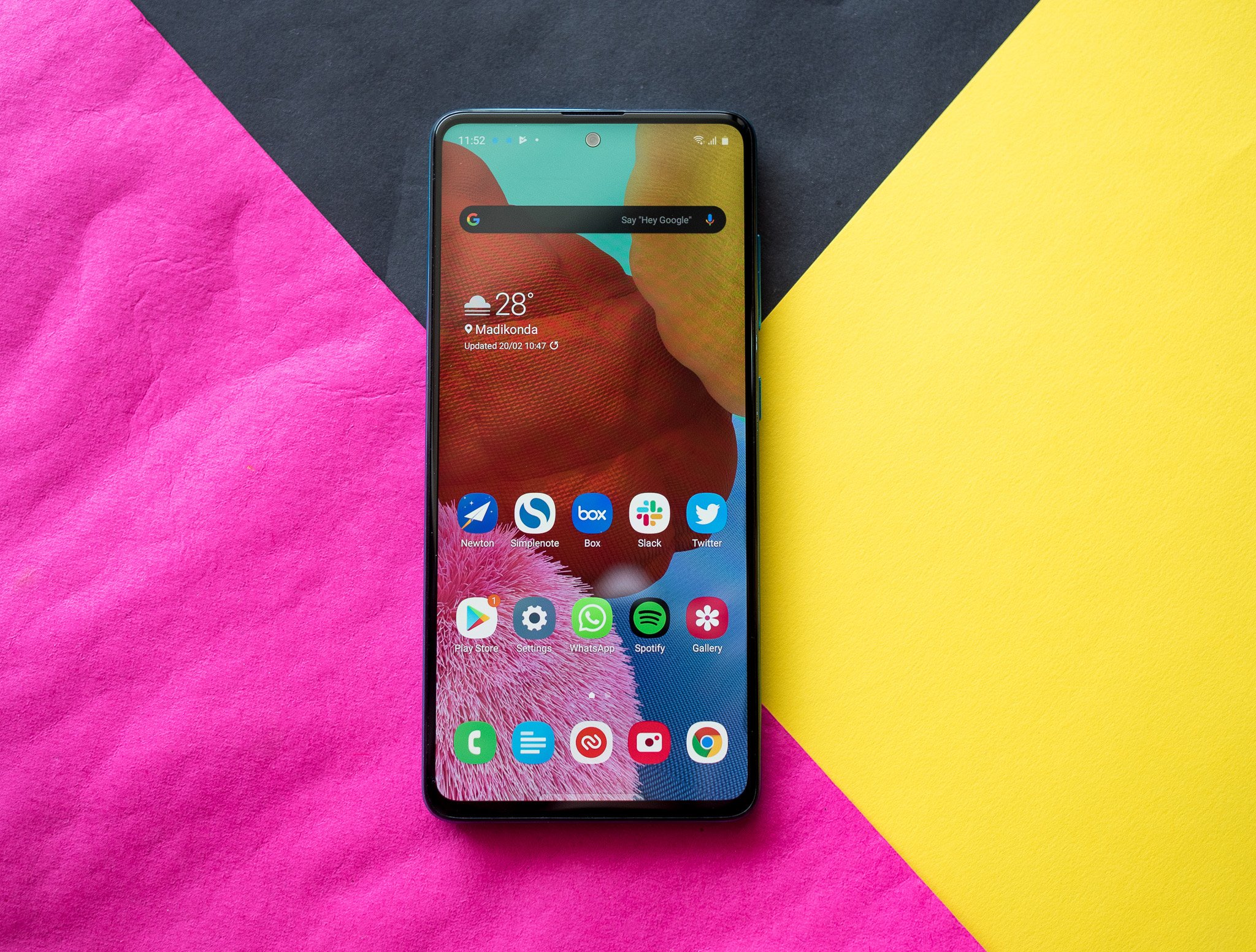 Source: Apoorva Bhardwaj / Android Central
Source: Apoorva Bhardwaj / Android Central
Samsung has been recycling hardware on its phones for several years, and it’s no different on the Galaxy A51. The phone is powered by the Exynos 9611, the same as the A50s. The A50 had the Exynos 9610, and while the Exynos 9611 is marketed as a new chipset, the only difference from the 9610 is that it can facilitate 48MP camera modules. Both the 9610 and 9611 use the same set of cores and the same Mali G72 for visuals, and they’re both fabricated on a 10nm node.
| Specs | Samsung Galaxy S10 Lite |
|---|---|
| Software | One UI 2.0 based on Android 10 |
| Display | 6.5-inch (2400×1080) Super AMOLED |
| Chipset | 2.30GHz Exynos 9611 |
| RAM | 4GB/6GB/8GB |
| Storage | 64GB/128GB |
| Rear Camera 1 | 48MP ƒ/2.0 (primary) |
| Rear Camera 2 | 12MP ƒ/2.2 (wide-angle) |
| Rear Camera 3 | 5MP ƒ/2.4 (macro) |
| Rear Camera 4 | 5MP ƒ/2.2 (portrait) |
| Front Camera 1 | 32MP ƒ/2.2 |
| Connectivity | Wi-Fi 802.11 ac, BT5.0, NFC |
| Battery | 4000mAh | 15W |
| Security | In-screen fingerprint |
| Colors | Prism Crush Black, Prism Crush White, Prism Crush Blue |
| Dimensions | 158.5 x 73.6 x 7.9mm |
| Weight | 172g |
If anything, Samsung is shortchanging buyers on the storage front this year, with the A51 offering UFS 2.0 storage whereas last year’s A50 and A50s had UFS 2.1 storage. Let’s get back to the hardware, because Samsung’s decision to use the Exynos 9611 in the A51 makes things sluggish in day-to-day use. The chipset has four Cortex A73 cores at 2.3GHz and four energy-efficient A53 cores at 1.7GHz, and there’s just not enough grunt to handle even basic tasks like web browsing.
You will notice lag at times even while navigating the user interface, with actions like opening the app drawer causing a negligible delay. Then there’s the issue of gaming, and the Mali G72 just does not hold up in titles like PUBG and Fortnite. If you’re serious about mobile gaming, you’re better off picking a phone with a Snapdragon 730 instead. The A51 is barely adequate even for everyday use — you should not be able to see lag when exiting an app to go to the home screen.
The phone is available with 6GB/128GB and 8GB/128GB variants in India, but in other markets Samsung will offer the A51 with a 4GB option. There’s a MicroSD slot that can accommodate cards up to 512GB in size, and you also get NFC with Samsung Pay, Bluetooth 5.0 LE, FM radio, and Wi-Fi ac. The optical in-display fingerprint sensor is fast and reliable, and I didn’t face any issues with it.
On the connectivity front, the A51 has LTE bands 1/2/3/4/5/7/8/12/17/20/26/28/38/40/41/66. That should be more than adequate to connect to most LTE networks around the world, and with the phone slated to go on sale in global markets, Samsung will tailor LTE bands according to the region.
Yet another area where things are unchanged is battery. The A51 has the same 4000mAh battery with 15W fast charging, and I didn’t have any issues with battery longevity. The phone manages to last a day with ease, and although the hardware itself hasn’t changed from the A50, I got better battery usage figures on the A51.

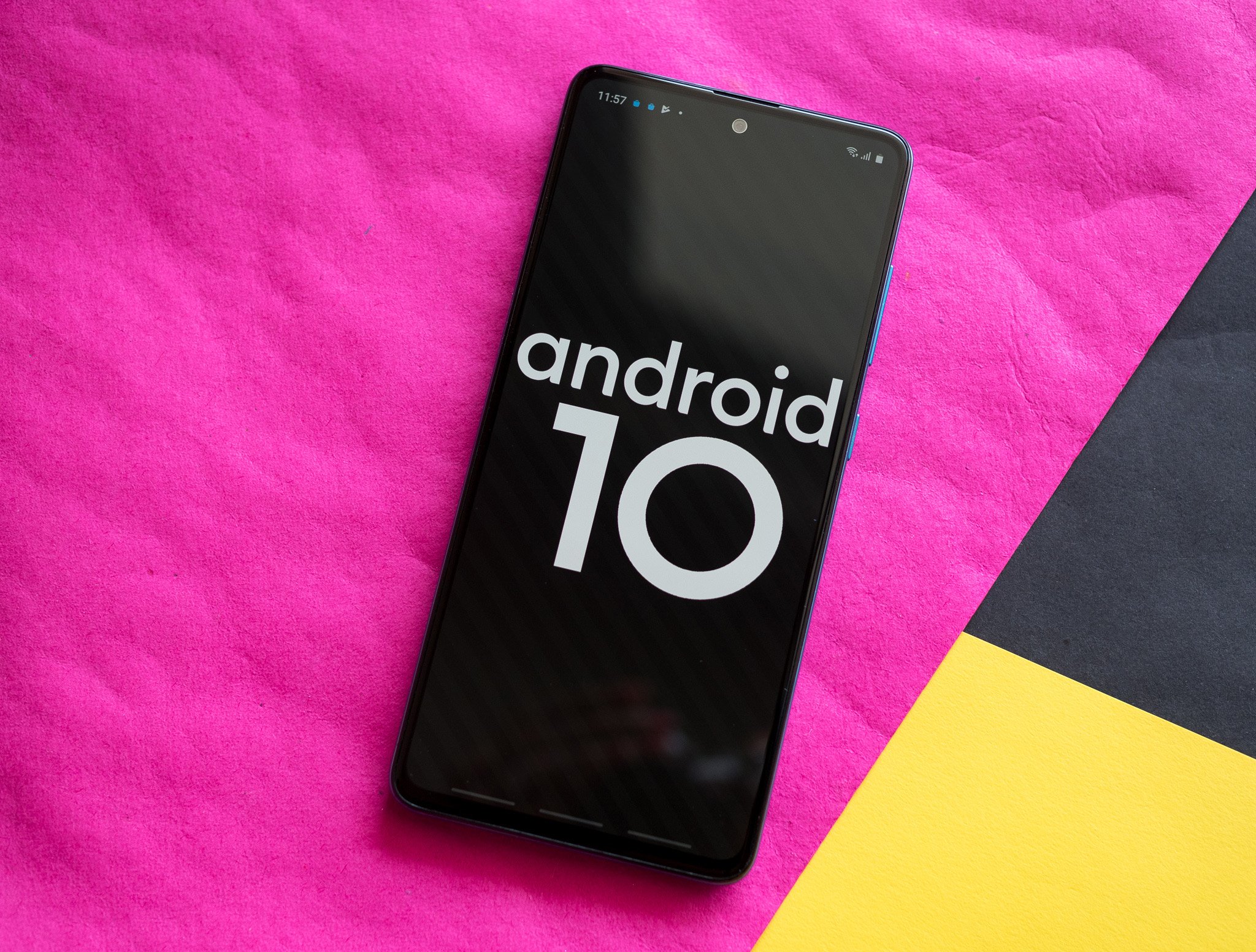 Source: Apoorva Bhardwaj / Android Central
Source: Apoorva Bhardwaj / Android Central
One of the highlights of the A51 is that it comes with One UI 2.0 based on Android 10 out of the box. That wasn’t always the case with Samsung’s budget phones, so it is great to see the manufacturer offer its latest UI on all of its 2020 phones. One UI 2.0 integrates Android 10’s system-wide dark mode, and you also get the ability to choose from Android 10’s default navigation gestures or Samsung’s take.
One UI 2.0 comes with Android 10 and a treasure trove of customization options.
Samsung’s gestures include designated zones at the bottom of the screen from where you swipe up. It is an elegant solution, and is easier to get acclimated to if you’re switching from the legacy navigation keys. But the fact that you also get Android 10’s gestures — with the swipe-in from either side to go back, and swipe up from the bottom of the screen to go to the home screen — makes it that much more enticing.
Samsung has always offered a healthy list of customization features, and it’s no different on the A51. You now get Edge screen, with the ability to configure pull-out Edge panels and set up Edge lighting for incoming notifications and calls. Edge lighting makes up for the fact that phones these days don’t have an LED notification light, and there’s just a lot of customizability to choose from here.
The A51 also has software-based face unlock, and while it isn’t as secure as a fingerprint reader, it is fast. Elsewhere, you get the ability to use two instances of an app at once, Bixby, off-screen gestures, Digital Wellbeing controls, and one-handed mode. Samsung made a dedicated effort to modernize its UI in recent years, and the result is that One UI 2.0 feels modern and a far cry from the TouchWiz days.

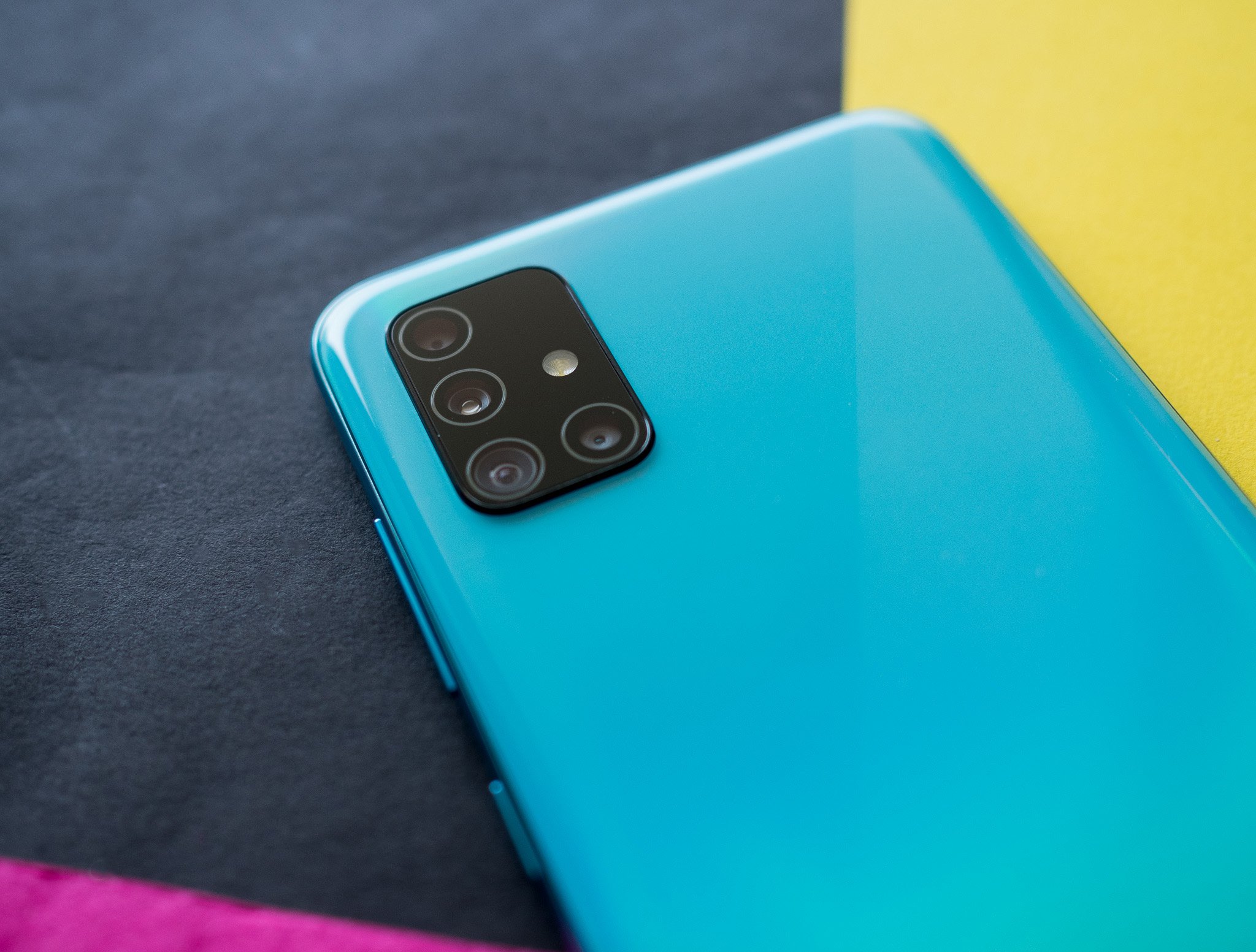 Source: Apoorva Bhardwaj / Android Central
Source: Apoorva Bhardwaj / Android Central
The highlight with the Galaxy A51 is the quad camera array at the back: there’s now a 48MP primary camera joined by a 12MP wide-angle lens, 5MP macro shooter, and another 5MP lens for portrait mode. You get a 32MP camera up front, which is a minor upgrade from the 25MP shooter on last year’s A50.
The camera interface itself should be immediately familiar if you’ve used a Samsung phone recently. The main shooting modes are laid out in a ribbon at the bottom, and you can edit these as needed based on your preferences. There are toggles for flash, timer, filters and beautify effects, and you can easily switch between the primary lens and wide-angle shooter.
The 48MP camera is a known quantity at this point, and it takes great shots in daylight conditions. Resultant images have plenty of detail and decent dynamic range, and you get those saturated colors that define Samsung’s cameras. One of the biggest changes Samsung made in 2020 is with the ultra-wide lens, with the shooter managing to produce shots with the same level of detail as the primary lens.
As good as the A51 is in daylight conditions, shots in artificial or low lighting are a blotchy mess. There’s far too much noise, colors are washed out, and the final images are just nowhere near good enough for sharing on social platforms.
The macro lens does not have autofocus, and it struggles to dial in on busy subjects, like a watch face. Regardless of what I tried, I could not get it to focus on the watch face of my Promaster Skyhawk, and although the 5MP resolution is higher than what you get with most other phones, the macro lens is still very limited in its usability.

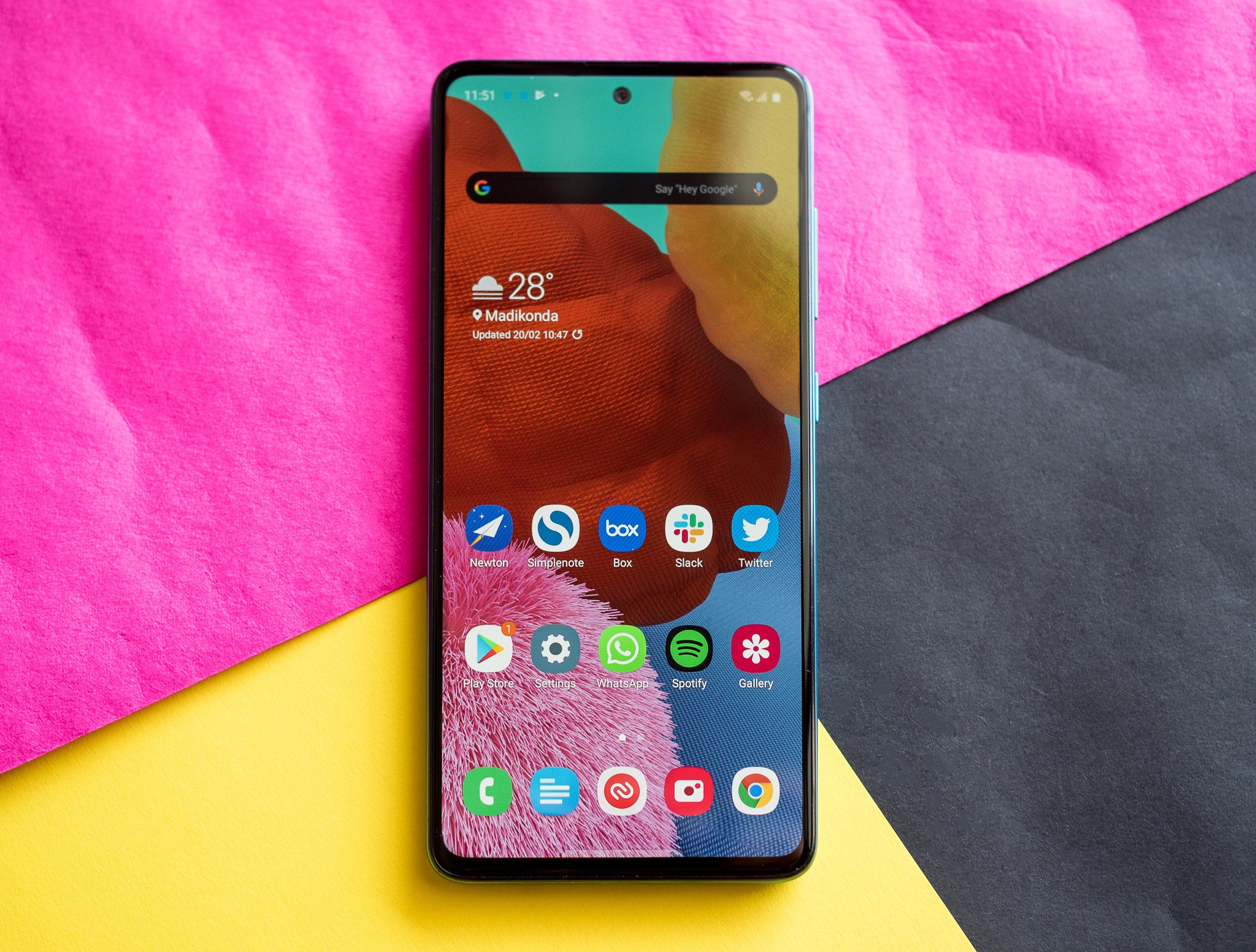 Source: Apoorva Bhardwaj / Android Central
Source: Apoorva Bhardwaj / Android Central
The Galaxy A51 isn’t vastly different from what Samsung offered in this segment last year, but the upgrades to the camera and design allow it to stand out. The 48MP camera takes decent shots during the day, the display is one of the best you’ll find in this segment, the battery life is fantastic, and you get the latest One UI 2.0 based on Android 10.
There are far too many trade-offs here to justify the $350 price tag.
That said, the hardware is slow compared to the rest of the field, and you will see noticeable lag in day-to-day use. Also, it doesn’t make sense to switch to the Galaxy A51 if you’re already using the A50 or A50s, because for the most part this is the same phone that Samsung released last year.
Obviously, the Galaxy A51 doesn’t make much sense for the Indian market, because there are phones that offer much better value and beefier hardware in 2020. The Realme X2 Pro, Redmi K20, or the POCO X2 would be a better option if you’re in the market for a phone under ₹25,000 ($350).
However, none of those phones will make it to most Western markets — unlike the Galaxy A51. The A51 will be going on sale in the U.S. and other global markets in a few months, and while there aren’t many devices at the $350 price point, there are a few options like the Pixel 3a. If you’re spending $350 on a phone in 2020, you’ll want usable hardware, and the A51 fails to deliver on that front.
If you want to save some cash, you can just get the Galaxy A50s for ₹19,999 ($280) and get a phone that’s nearly identical to the A51. Or if you’re in the market for a device for gaming, the POCO X2 at ₹16,999 ($236) is my recommendation.
There aren’t many alternatives to the Galaxy A51 in global markets. Samsung dominated with the Galaxy A50 last year for this reason alone, and while the phone by itself had a lot going for it, that isn’t the case with the Galaxy A51. If you need a phone for under $400, you should pick up the Pixel 3a or wait for Google to launch the Pixel 4a series.
Decent design letdown by poor hardware.
The Galaxy A51 shares the same fundamentals of last year’s A50 and A50s. The 48MP camera takes decent shots during the day, you get all-day battery life, a vibrant AMOLED display, 3.5mm jack, and Android 10. But the hardware just doesn’t hold up in 2020, and there are much better alternatives available at the same price point.
We may earn a commission for purchases using our links. Learn more.

Although no one likes a know-it-all, they dominate the Internet.
The Internet began as a vast repository of information. It quickly became a breeding ground for self-proclaimed experts seeking what most people desire: recognition and money.
Today, anyone with an Internet connection and some typing skills can position themselves, regardless of their education or experience, as a subject matter expert (SME). From relationship advice, career coaching, and health and nutrition tips to citizen journalists practicing pseudo-journalism, the Internet is awash with individuals—Internet talking heads—sharing their “insights,” which are, in large part, essentially educated guesses without the education or experience.
The Internet has become a 24/7/365 sitcom where armchair experts think they’re the star.
Not long ago, years, sometimes decades, of dedicated work and acquiring education in one’s field was once required to be recognized as an expert. The knowledge and opinions of doctors, scientists, historians, et al. were respected due to their education and experience. Today, a social media account and a knack for hyperbole are all it takes to present oneself as an “expert” to achieve Internet fame that can be monetized.
On the Internet, nearly every piece of content is self-serving in some way.
The line between actual expertise and self-professed knowledge has become blurry as an out-of-focus selfie. Inadvertently, social media platforms have created an informal degree program where likes and shares are equivalent to degrees. After reading selective articles, they’ve found via and watching some TikTok videos, a person can post a video claiming they’re an herbal medicine expert. Their new “knowledge,” which their followers will absorb, claims that Panda dung tea—one of the most expensive teas in the world and isn’t what its name implies—cures everything from hypertension to existential crisis. Meanwhile, registered dietitians are shaking their heads, wondering how to compete against all the misinformation their clients are exposed to.
More disturbing are individuals obsessed with evangelizing their beliefs or conspiracy theories. These people write in-depth blog posts, such as Elvis Is Alive and the Moon Landings Were Staged, with links to obscure YouTube videos, websites, social media accounts, and blogs. Regardless of your beliefs, someone or a group on the Internet shares them, thus confirming your beliefs.
Misinformation is the Internet’s currency used to get likes, shares, and engagement; thus, it often spreads like a cosmic joke. Consider the prevalence of clickbait headlines:
Titles that make outrageous claims are how the content creator gets reads and views, which generates revenue via affiliate marketing, product placement, and pay-per-click (PPC) ads. Clickbait headlines are how you end up watching a TikTok video by a purported nutrition expert adamantly asserting you can lose belly fat while you sleep by drinking, for 14 consecutive days, a concoction of raw eggs, cinnamon, and apple cider vinegar 15 minutes before going to bed.
Our constant search for answers that’ll explain our convoluted world and our desire for shortcuts to success is how Internet talking heads achieve influencer status. Because we tend to seek low-hanging fruits, we listen to those with little experience or knowledge of the topics they discuss yet are astute enough to know what most people want to hear.
There’s a trend, more disturbing than spreading misinformation, that needs to be called out: individuals who’ve never achieved significant wealth or traded stocks giving how-to-make-easy-money advice, the appeal of which is undeniable. Several people I know have lost substantial money by following the “advice” of Internet talking heads.
Anyone on social media claiming to have a foolproof money-making strategy is lying. They wouldn’t be peddling their money-making strategy if they could make easy money.
Successful people tend to be secretive.
Social media companies design their respective algorithms to serve their advertisers—their source of revenue—interest; hence, content from Internet talking heads appears most prominent in your feeds. When a video of a self-professed expert goes viral, likely because it pressed an emotional button, the more people see it, the more engagement it receives, such as likes, shares and comments, creating a cycle akin to a tornado.
Imagine scrolling through your TikTok feed and stumbling upon a “scientist” who claims they can predict the weather using only aluminum foil, copper wire, sea salt and baking soda. You chuckle, but you notice his video got over 7,000 likes, has been shared over 600 times and received over 400 comments. You think to yourself, “Maybe this guy is onto something.” What started as a quest to achieve Internet fame evolved into an Internet-wide belief that weather forecasting can be as easy as DIY crafts.
Since anyone can call themselves “an expert,” you must cultivate critical thinking skills to distinguish genuine expertise from self-professed experts’ self-promoting nonsense. While the absurdity of the Internet can be entertaining, misinformation has serious consequences. The next time you read a headline that sounds too good to be true, it’s probably an Internet talking head making an educated guess; without the education seeking Internet fame, they can monetize.
______________________________________________________________
Nick Kossovan, a self-described connoisseur of human psychology, writes about what’s
on his mind from Toronto. You can follow Nick on Twitter and Instagram @NKossovan.

TORONTO – A new survey says a majority of software engineers and developers feel tight project deadlines can put safety at risk.
Seventy-five per cent of the 1,000 global workers who responded to the survey released Tuesday say pressure to deliver projects on time and on budget could be compromising critical aspects like safety.
The concern is even higher among engineers and developers in North America, with 77 per cent of those surveyed on the continent reporting the urgency of projects could be straining safety.
The study was conducted between July and September by research agency Coleman Parkes and commissioned by BlackBerry Ltd.’s QNX division, which builds connected-car technology.
The results reflect a timeless tug of war engineers and developers grapple with as they balance the need to meet project deadlines with regulations and safety checks that can slow down the process.
Finding that balance is an issue that developers of even the simplest appliances face because of advancements in technology, said John Wall, a senior vice-president at BlackBerry and head of QNX.
“The software is getting more complicated and there is more software whether it’s in a vehicle, robotics, a toaster, you name it… so being able to patch vulnerabilities, to prevent bad actors from doing malicious acts is becoming more and more important,” he said.
The medical, industrial and automotive industries have standardized safety measures and anything they produce undergoes rigorous testing, but that work doesn’t happen overnight. It has to be carried out from the start and then at every step of the development process.
“What makes safety and security difficult is it’s an ongoing thing,” Wall said. “It’s not something where you’ve done it, and you are finished.”
The Waterloo, Ont.-based business found 90 per cent of its survey respondents reported that organizations are prioritizing safety.
However, when asked about why safety may not be a priority for their organization, 46 per cent of those surveyed answered cost pressures and 35 per cent said a lack of resources.
That doesn’t surprise Wall. Delays have become rampant in the development of tech, and in some cases, stand to push back the launch of vehicle lines by two years, he said.
“We have to make sure that people don’t compromise on safety and security to be able to get products out quicker,” he said.
“What we don’t want to see is people cutting corners and creating unsafe situations.”
The survey also took a peek at security breaches, which have hit major companies like London Drugs, Indigo Books & Music, Giant Tiger and Ticketmaster in recent years.
About 40 per cent of the survey’s respondents said they have encountered a security breach in their employer’s operating system. Those breaches resulted in major impacts for 27 per cent of respondents, moderate impacts for 42 per cent and minor impacts for 27 per cent.
“There are vulnerabilities all the time and this is what makes the job very difficult because when you ship the software, presumably the software has no security vulnerabilities, but things get discovered after the fact,” Wall said.
Security issues, he added, have really come to the forefront of the problems developers face, so “really without security, you have no safety.”
This report by The Canadian Press was first published Oct. 8, 2024.
Companies in this story: (TSX:BB)
The Canadian Press. All rights reserved.

As online shoppers hunt for bargains offered by Amazon during its annual fall sale this week, cybersecurity researchers are warning Canadians to beware of an influx of scammers posing as the tech giant.
In the 30 days leading up to Amazon’s Prime Big Deal Days, taking place Tuesday and Wednesday, there were more than 1,000 newly registered Amazon-related web domains, according to Check Point Software Technologies, a company that offers cybersecurity solutions.
The company said it deemed 88 per cent of those domains malicious or suspicious, suggesting they could have been set up by scammers to prey on vulnerable consumers. One in every 54 newly created Amazon-related domain included the phrase “Amazon Prime.”
“They’re almost indiscernible from the real Amazon domain,” said Robert Falzon, head of engineering at Check Point in Canada.
“With all these domains registered that look so similar, it’s tricking a lot of people. And that’s the whole intent here.”
Falzon said Check Point Research sees an uptick in attempted scams around big online shopping days throughout the year, including Prime Days.
Scams often come in the form of phishing emails, which are deceptive messages that appear to be from a reputable source in attempt to steal sensitive information.
In this case, he said scammers posing as Amazon commonly offer “outrageous” deals that appear to be associated with Prime Days, in order to trick recipients into clicking on a malicious link.
The cybersecurity firm said it has identified and blocked 100 unique Amazon Prime-themed scam emails targeting organizations and consumers over the past two weeks.
Scammers also target Prime members with unsolicited calls, claiming urgent account issues and requesting payment information.
“It’s like Christmas for them,” said Falzon.
“People expect there to be significant savings on Prime Day, so they’re not shocked that they see something of significant value. Usually, the old adage applies: If it seems too good to be true, it probably is.”
Amazon’s website lists a number of red flags that it recommends customers watch for to identify a potential impersonation scam.
Those include false urgency, requests for personal information, or indications that the sender prefers to complete the purchase outside of the Amazon website or mobile app.
Scammers may also request that customers exclusively pay with gift cards, a claim code or PIN. Any notifications about an order or delivery for an unexpected item should also raise alarm bells, the company says.
“During busy shopping moments, we tend to see a rise in impersonation scams reported by customers,” said Amazon spokeswoman Octavia Roufogalis in a statement.
“We will continue to invest in protecting consumers and educating the public on scam avoidance. We encourage consumers to report suspected scams to us so that we can protect their accounts and refer bad actors to law enforcement to help keep consumers safe.”
Falzon added that these scams are more successful than people might think.
As of June 30, the Canadian Anti-Fraud Centre said there had been $284 million lost to fraud so far this year, affecting 15,941 victims.
But Falzon said many incidents go unreported, as some Canadians who are targeted do not know how or where to flag a scam, or may choose not to out of embarrassment.
Check Point recommends Amazon customers take precautions while shopping on Prime Days, including by checking URLs carefully, creating strong passwords on their accounts, and avoiding personal information being shared such as their birthday or social security number.
The cybersecurity company said consumers should also look for “https” at the beginning of a website URL, which indicates a secure connection, and use credit cards rather than debit cards for online shopping, which offer better protection and less liability if stolen.
This report by The Canadian Press was first published Oct. 8, 2024.


In The Rings: Curling Canada still looking for Canadian Curling Trials title sponsor


N.B. election debate: Tory leader forced to defend record on gender policy, housing


After hurricane, with no running water, residents organize to meet a basic need


Alberta government shifts continuing care from Health to Seniors Ministry


Buhai, Green and Shin lead in South Korea after 8-under 64s in first round


Manitoba government halts school building plan, says other methods will be found


Maple Leafs winger Bobby McMann finding game after opening-night scratch


‘Significant overreach’: Ontario municipalities slam province over bike lane rules